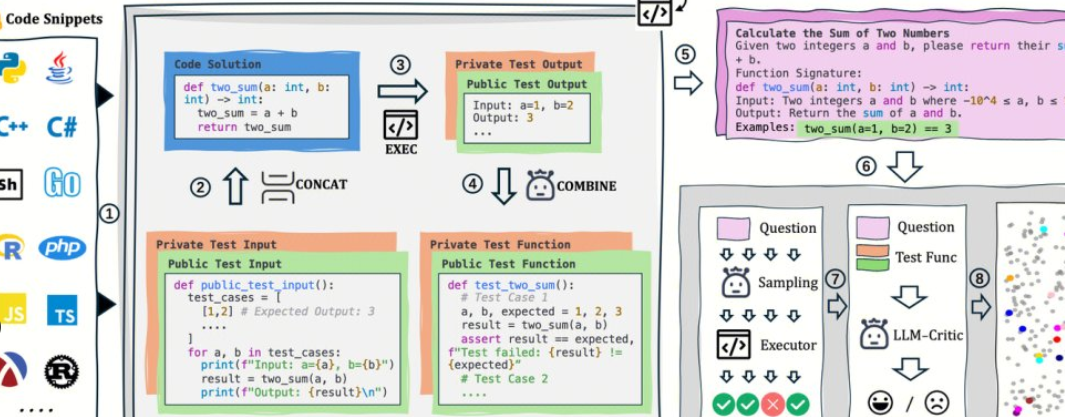AutoCodeBench is open-sourced by Tencent's Hunyuan team, and its core is an automated workflow of "LLM generation + multilingual sandbox validation". The project also open-sources AutoCodeGen (data synthesis), AutoCodeBench (three sets of benchmarks, Full / Lite / Complete), and MultiLanguageSandbox (30+ language sandboxes) to evaluate the multilingual coding capabilities of Base and Chat models, and support self-generation of new benchmarks.
1. Project Overview and Value
1. No manual annotation: LLM is used to synthesize questions and reference answers, and verifiable standard outputs are automatically generated through the sandbox.
2. Multilingual and difficult: Covering 20 programming languages and 3,920 practical problems, the difficulty layering is closer to real development.
3. Evaluation and data are the same source: the same process can not only generate data, but also play back the evaluation, which is convenient for reproducibility and horizontal comparison.
2. Open source address
1. Project homepage: https://autocodebench.github.io
2. Paper: https://arxiv.org/abs/2508.09101
3. Codebase: https://github.com/Tencent-Hunyuan/AutoCodeBenchmark
4. Dataset: https://huggingface.co/datasets/tencent/AutoCodeBenchmark
3. Data and benchmark composition
1. Full: 3,920 questions, covering 20 languages, emphasizing difficulty and diversity.
2. Lite: 1,586 questions, screened by cross-model "solvability", which is more conducive to quick comparison.
3. Complete: 1,000 questions, 3-shot setting, code completion evaluation for the Base model.
4. Language and difficulty: Balanced sampling according to language, the difficulty is divided into easy/medium/hard, taking into account both breadth and intensity.
4. Evaluation paradigm and indicators
1. Unified instructions: require the output of a single code block, without running commands and examples.
2. Sandbox verification: Compile/run the generated code topic-by-topic, calculate objective indicators such as pass@1.
3. Two-line evaluation: Simultaneously covers Chat generation and Base completion to reduce the bias of "only testing the dialogue model".
5. Get started quickly (5 steps)
1. Prepare the output: Use your model to generate code for questions in autocodebench.jsonl question by question and save it as model_output.jsonl.
2. Pull the image: docker pull hunyuansandbox/multi-language-sandbox:v1.
3. Start the service: docker run -d --name sandbox -p 8080:8080 hunyuansandbox/multi-language-sandbox:v1.
4. Health check: Submit the minimum sample to POST /submit to confirm that the compilation/execution is normal.
5. Calculation metrics: Use warehouse scripts to call sandboxes in batches, generate execution results, and count pass@1.
6. Typical applications and applicable groups
1. Model team: cross-language regression and version comparison, locate compilation failure/boundary use cases.
2. Scientific research evaluation: Build high-quality multilingual benchmarks at low cost to improve reproducibility.
3. Enterprise internal testing: Use Lite/Complete to do grayscale evaluation, observe stability and long-tail questions.
7. Practical suggestions
1. Lite first and then Full: Quickly screen first, and then do a comprehensive regression and report.
2. Concurrency and quotas: Sandbox compilation/running is a bottleneck, and it is recommended to schedule queues and implement them in a distributed manner.
3. Observability: Failure of record by type (compilation/run/boundary/time limit), targeted optimization prompts and hyperparameters.
4. Cooperate with RAG: Long questions and cross-file tasks are combined with search enhancements to enhance stability.
8. Limitations and risk warnings
1. Environmental consistency: Mirroring and dependencies will affect the pass rate, and it is necessary to lock the version and random seeds.
2. Data compliance: When the topic and code involve external databases, it is necessary to do a good job of isolation and auditing.
3. Extrapolated boundary: The benchmark score is not equal to production availability, and real business sample A/B is still required.
9. Frequently Asked Questions
1. Is it really "fully automatic and zero manual annotation"?
The process is centered on LLM generation and sandbox verification, and does not rely on manual annotation on a topic-by-topic basis. Manual sampling of key samples is recommended to check the quality.
2. What languages are supported, and is it biased towards Python?
The sandbox supports 30+ languages and covers 20 programming languages with data balancing, significantly reducing the "Python only" bias.
3. How to evaluate Chat and Base at the same time?
Chat generates code directly from unified system prompts; Base uses Complete's 3-shot completion settings to keep the evaluation protocol consistent.
4. Can I use the same workflow to generate custom baselines?
OK. AutoCodeGen automatically synthesizes new questions and test sets in a sandbox using the same verification and scoring process.




